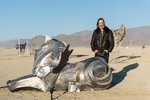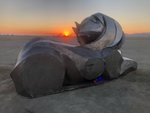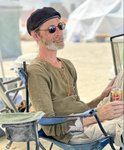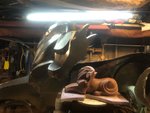




Winlock artist Michael Duquette always wanted to go to the Burning Man Project but never found the time or money to go.
After experiencing the iconic event this year, his one piece of advice to anyone who asks is if they have ever even thought they wanted to go, they definitely should.
“It’s absolutely game-changing and it really does reset your way of looking at things,” Duquette said. “Burning Man was like stepping into what the human race should be.”
What made Duquette’s visit to the experience in Black Rock City, Nevada, this year even more memorable was he didn’t go as a spectator. He got to be part of bringing art to the desert.
It all started when Duquette got a call this spring from his brother, who works as a cattleman, who had heard about an arts contest that was taking submissions. Submissions were being sought from artists for designs for life-sized or larger horse sculptures that would be shown together in a herd formation at Burning Man called “Wild Horses of the American West.” Honorariums for chosen artists would be funded by the Coalition for Healthy Nevada Lands, Wildlife and Free-Roaming Horses, the Sierra Arts Foundation and Artech.
The purpose of the project was to draw attention to the plight of wild horses in Nevada, which are dying due to lack of natural resources.
Duquette said he found the assignment intriguing both for the potential location of the installation and also because he has always drawn a great deal of inspiration from nature.
“I love the natural world,” Duquette said. “I’m an environmentalist at heart.”
He submitted a sketch and was one of 14 artists who were chosen. Ultimately, 16 sculptures made it to the playa for the event, which took place Aug. 28 to Sept. 5.
Once he was notified his design was chosen, Duquette had just 60 days to bring his sculpture to life. He said he worked 12 to 14 hours each day, focusing on no other projects during that time. He worked all the way up until 6:30 a.m. the morning he needed to leave to drive his sculpture to Nevada.
“I had to tell people, most of my regular clients, ‘OK, I’m going to disappear for a little while,’” Duquette recalled of taking on the task.
While Duquette has completed other sculptures in a similar timeframe, the horse sculpture was unique in that he decided to challenge himself and use some metalworking techniques that were new to him. He purchased an English Wheel, which is a machine that allows artists to make complex curves on metal with a smooth surface that hammering does not allow. Though the machine helped the work go faster than hammering might have, Duquette initially did not know how to use it and had to teach himself through YouTube videos.
During the creation process, Duquette met weekly via Zoom with the other artists who were also creating horse sculptures for the event. There were artists from the United Kingdom, Germany and Mongolia in addition to the American artists. Once they arrived at Burning Man, these artists were camped next to each other. Duquette said it was really fun to finally meet them in person, see their artwork come together and experience this event together.
“Instant family,” Duquette said of the group of artists. “We all keep in touch. It was like if you walked into a city and everybody there was your family.”
The completed project is a minimalist metal sculpture of a reclining horse he gave the name of the equation E0=MC2 (E Subzero=MC Squared), which literally means power at rest. When it was completed, Duquette drove it to the Nevada desert to attend Burning Man. He said the nine-day gathering is immense, spanning a 9-mile radius and having between 50,000 and 80,000 people at any given time.
The event is completely cashless. Visitors bring everything they need and they barter or trade for anything else they require. Duquette said the central Burning Man sculpture, which is burned at the end of the event, was amazing. But he found the temple, where people bring items to be left and burned that symbolize what they want to leave behind, the most moving of his experiences there. Duquette said many of the photos and notes this year were about those lost to the COVID-19 pandemic.
“I wasn’t 4 feet inside and I started to cry,” Duquette said of the Burning Man temple. “It opens your heart and rips it out and everyone else there is feeling the same way. It’s such a unifying thing.”
Duquette has been interested in creating art for as along as he can remember. His first love is stone carving, particularly limestone, but he has worked in a number of mediums, including metal and even created steampunk sculptures with recycled materials.
He created his first commissioned sculpture for a park in his hometown of Kent when he was still in high school. In Lewis County, some of his notable pieces include an Atlas figure near the reception desk at the Centralia Square Hotel and the “Winlock Express” train sculpture in Winlock.
He said after working on the horse sculpture for Burning Man, he would like to do some more metal work in the form of either a life-sized shark or a giant scorpion figure.
After the Burning Man event ended, all of the horse sculptures in “Wild Horses of the American West” were moved to the entrance of the Reno/Tahoe International Art Show and now will travel to various locations around the Reno and Sparks, Nevada areas until June 2023.
The horse sculptures are planned to be auctioned in 2023 with the proceeds being split between the artists and the commissioning partners.